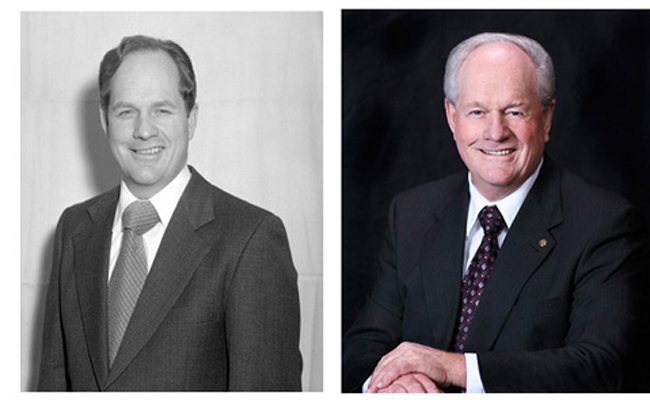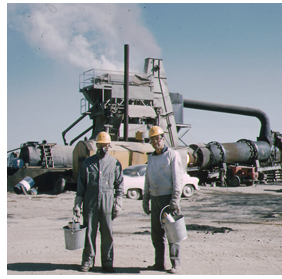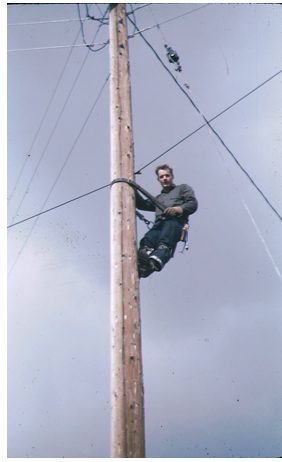

Pictured: Reese in 1975, and Reese in 2012. Lotwick hits his 50-year milestone on Feb. 24, 2015.
Reese celebrates half a century of watershed moments
When he started with the Idaho Highway Department (later ITD), gas was 19 cents a gallon and he earned $1.30 per hour. There was no retirement system, PERSI or otherwise. His first semester’s tuition in college was $160. He bought a brand new station wagon for $2,800.
Over the years, a lot has changed for Lotwick Reese, and one of these days, one more thing may change: after 50 years of state service, he will no longer roam these halls.
In late February, Reese will have a half-century under his belt — 104,000 state hours. It’s a staggering number. When Reese chooses to walk away, a refreshingly humble attitude will go with him. He said if he ever wrote his memoirs the title would be, “Someday I Hope To Become A Great Engineer” — but those lucky enough to know him understand that he is already there.
To know how he got there, though, one must go back to the beginning, when he was 17 and just looking for a job.
Looking for a job, found a career
“I needed a summer job. They were getting ready to rebuild 10 miles of U.S. Highway 89 in front of our home on the west side of Bear Lake Valley. I heard that the Highway Department might be hiring for the upcoming construction, so I drove to Montpelier and talked to newly assigned Resident Engineer Donald L. Cox.
 Pictured to left: Project Chief Harvey Kunz (on left) and Lotwick in 1961 at the Montpelier Residency test trailer. Reese was 23 years old.
Pictured to left: Project Chief Harvey Kunz (on left) and Lotwick in 1961 at the Montpelier Residency test trailer. Reese was 23 years old.
“Don told me he couldn’t hire me until I turned 18, so a week or so after I turned 18, Don hired me as a rear chainman on a survey crew, even though I hadn’t yet graduated from high school. I got permission from my high school principal to work part time for a few weeks until I graduated, on the condition I kept my grades up,” Reese recalls.
That eventually worked into an offer for full-time employment as the residency office manager, from newly promoted Resident Chief Tommy Thomas.
“Tommy took me under his wing and taught me everything about roadway design and construction for the next five years,” said Reese.
The five years working with resident engineers, design engineers and district engineers instilled in Lotwick an intense desire to pursue schooling in that field.
“At that time, the Bachelor of Engineering Science degree at Brigham Young University was a five-year degree, but it took me six years because I was working part time as a draftsman/designer for a consulting firm owned by two of the Civil Engineering professors at the university,” Reese said.
Thomas hired Lotwick each summer of those six years to return to work at the Montpelier Residency during the summer months as his Bridge Construction Inspector.
Pictured to right: Reese (on left) and Instrument Man Blaire Thorpe prepare to "enter the inferno" in 1961. Thorpe, from the Malad Residency, and Reese, from the Montpelier Residency, had to wear gasmasks and goggles to sample hotplant aggregates.
After graduating from BYU with honors in the Hydraulic program, Reese received an offer from the Federal Highway Administration that took him to Lompoc, Calif.; Topeka, Kansas; Salem, Ore.; and eventually to Washington, D.C., to work with their Headquarters Hydraulics Branch.
Wanting to return to his roots in Idaho, Reese accepted an offer with ITD to work in the Bridge Design Section in Boise. After a year or two, the department advertised for the first State Hydraulic Engineer, which Lotwick quickly applied for and was selected. He counts being selected to fill that spot as his most memorable accomplishment at ITD. Reese said the other most-memorable items included:
- Being chosen to represent ITD, Idaho and the northwestern states on the American Association of State Highway and Transportation Officials (AASHTO) Hydrology and Hydraulics Technical Committee for the past 19 years.
- In 2007, Reese received the American Society of Civil Engineers “Outstanding Civil Engineering Achievement Award” for contributions that restored historic fish passages in eastern Idaho. The featured project replaced old arched pipe culverts that impeded fish passage with clear-span bridges, and new channel designs with natural meanders, pools and riffles. “This innovative design created a ‘fish-friendly’ environment for the revered Yellowstone Cutthroat Trout to migrate from Henry’s Lake, up Targhee and Howard creeks, to their natural spawning habitat for the first time in 50 years,” he explained.
- In 2011, Reese received the AASHTO Region 4 Design Award, recognizing the outstanding engineer from a group of 18 states located west of the Mississippi River.
- At the National Hydraulic Engineering Conference in Nashville, Tenn., in August 2012, Reese was awarded the Mark Miles National Hydraulic Engineer Award. This is only the second time this prestigious award has been presented. He was selected by the Nominations Committee representing department of transportation state hydraulic engineers from the 50 states, the Canadian provinces, Federal Highway Administration hydraulic engineers, their consultants and research engineers.
“Other than a few years with FHWA, with a private consulting firm and the Idaho Department of Water Resources, ITD has been my home,” Reese stated.
“And it has been a good home, where I have always felt at home. It will be impossible to adequately express my thanks and my deep gratitude to all of those who have played a part and contributed to whatever success I have achieved over the years. But there are a number of good men, many who are now gone and many that are still here, that fit into that category.
“It has been a great blessing for me to have found a profession, a science, and a never-ending study — the field of hydraulic engineering — that I have loved and had the privilege to be part of through most of my adult life. And as I have said many times, it has been more than a job; it has been a passion for me. “
Reese: The Early Years
Things have changed dramatically over the years. When he started in the Montpelier Residency, Lotwick and his colleagues:
- did all correspondence with an Underwood typewriter using carbon sheets for copies
- used an old Monroe hand-crank calculator to run all computations
- heated the residency office with an old stoker-fed coal furnace. Lotwick had to go to the basement, fill it with coal, and dig the clinkers out each morning so the furnace wouldn’t clog up with the orange-hot, incombustible coal residue.
Reese: milestone moments
- One of his first assignments as State Hydraulic Engineer was for Reese to investigate why the inverted siphon under the I-15/Malad Interchange would not carry water. He took the Malad Residency Survey Crew out and after some surveying found the siphon had been constructed upside down. In other words, the outlet elevation was higher than the inlet elevation. Reese re-designed the siphon.
- Early in his career as State Hydraulic Engineer, the chief engineer assigned Reese to investigate why the I-90 Interstate washed out near Pinehurst. He spent several weeks in District 1, and after studying some aerial photography and field surveys, determined that Pine Creek would have to be realigned and that an off-ramp bridge was not large enough and would have to be replaced. He designed the realignment of Pine Creek and determined the correct sizing and elevation of the new off-ramp bridge.
Pictured to right: Reese in 1958 as a telephone lineman for Mountain Bell constructing interstate telephone toll-line from Las Vegas to Cedar City, Utah. Lotwick worked for Mountain Bell until ITD hired him full-time.
- Reese was assigned to work with the attorney general’s office to defend two lawsuits filed against ITD for flooding of private-property owners. During the Lemhi River 1988 flooding in Salmon, when the opposing attorneys learned of his discovery through aerial photographs that the property owner had built their home over an “oxbow” (a historic bend in the channel) of the Lemhi River, the property owner decided to drop the case. In the Lettunich Farms lawsuit from the Payette River flooding in 2000, after several weeks of preparation, Reese was to testify as an expert witness for the State, but just a day or two before the trial, the case was settled out of court.
- As chairman of the Interdisciplinary Scour Committee, Reese’s team prepared scour evaluations and action plans for over 400 scour-critical bridges throughout the state. Idaho got a late start, but ended up being one of the first of the 50 states to complete the scour evaluation of all their bridges. The Federal Highway Administration requested permission to post Idaho’s “Plan of Action” office manual and field manual on their website as a model for other states to use.
- In the fall of 2001, Reese coordinated the design and construction of one of the first A-Jacks installations nationwide on two bridges over the Snake River in eastern Idaho (District 5), the Ferry Butte (Tilden) Bridge near Blackfoot and the West Shelley Bridge. This was an experimental project to evaluate the application of A-Jacks as a suitable pier and abutment scour countermeasure. The A-Jacks were selected over conventional riprap placement because of their stability.
- In 2002, Reese worked with District 2 to solve a severe washout problem recurring on Idaho 11 known as “Greer Grade.” In conjunction with the district Design staff, he recommended and designed three massive 12-foot-high by 6-foot-diameter “stilling wells” to dissipate the energy of storm water runoff on extremely steep side slopes. This was the first design of its magnitude of the stilling well structures nationwide, and the Federal Highway Administration requested permission to include this design as an example in one of its hydraulic design manuals.
- In 2009, Reese and District 3 staff proposed contracting with Utah State University’s Water Research Laboratory to build a physical model of the I-84/Orchard Road Bridge crossing the New York Canal to investigate erosion. As the water in the canal flowed past the bridge piers, the channel geometry, flow conditions and pier spacing, combined with the natural frequency of the channel, created an alternating vortex in front of the pier columns that resulted in an oscillating energy wave in the channel. This destructive wave resulted in a major erosion of the channel banks and undermined the abutments of a bridge downstream. If left unchecked, the erosion would have compromised the integrity of the New York Canal and two bridges. USU graduate students constructed a 100-foot long, 1:9 scale model of the canal and bridge that replicated the oscillating wave. Through a number of experiments, the team designed a pre-cast “nose cone” that attached to the front of the piers, which stabilized the alternating vortices and resulting destructive oscillating wave. This was an extremely rare phenomenon and the only state in the country to introduce such a preventative measure. This project resulted in the savings of thousands of taxpayer’s dollars and was the recipient of the State “Engineering Excellence Award,” the “National Recognition Award” from the American Council of Engineering Companise (ACEC), and the “Excellence in Transportation Award” from the Idaho Transportation Department in 2012.
- Reese worked with the U.S. Geological Survey to develop “StreamStats,” a web-based interactive hydrology-modeling tool that makes it easy to get streamflow statistics, basin characteristics and other stream-related information online anytime. Idaho was the pilot state to implement this valuable resource, now being used by many other states.
Published 02-20-15